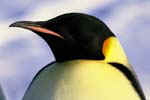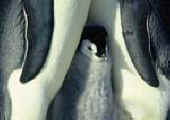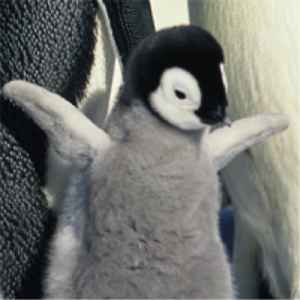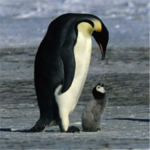By: debbie lynn elias
 For those of you that didn’t catch our earlier LA Film Festival coverage mentioning the most enchantingly adorable film of the year, this
For those of you that didn’t catch our earlier LA Film Festival coverage mentioning the most enchantingly adorable film of the year, this
week we take a closer look at what is sure to be not just an audience favorite, but Oscar contender, “March of the Penguins.” I had the privilege of being one of the first critics in America to review this exquisite work of art with the first internet review as well as print coverage right here in our own Culver City Observer and Santa Monica Observer. Starting with only 4 theaters less than one month ago, “March of the Penguins” opened this weekend on 800 screens and is simply the MUST SEE FILM OF THE YEAR.
 Antarctica was not always the pristine frozen tundra that we see today. On the contrary, eons ago, the land was warm and fertile, filed with a myriad of flora and fauna. But as the tides turned and the winds grew cold, in the truest sense of Darwinism (survival of the fittest), the little Emperor Penguin adapted to the ever changing world to become pretty much the only real resident of this now icy continent. And as part of that survival, the Emperor Penguin (some 3-4 feet in height and 90 pounds of cuteness) has returned each year to what has become their evolutionary breeding grounds “where each and every one of them has been born” for centuries. As testament to their innate adaptability, the penguins have long ago learned that “home” must be inland where the ice is thickest so as not to fall into the chilly seas when spring thaws the icy floes. Even young chicks have this innate sense of survival and seemingly without instruction know where to go and what! to do.
Antarctica was not always the pristine frozen tundra that we see today. On the contrary, eons ago, the land was warm and fertile, filed with a myriad of flora and fauna. But as the tides turned and the winds grew cold, in the truest sense of Darwinism (survival of the fittest), the little Emperor Penguin adapted to the ever changing world to become pretty much the only real resident of this now icy continent. And as part of that survival, the Emperor Penguin (some 3-4 feet in height and 90 pounds of cuteness) has returned each year to what has become their evolutionary breeding grounds “where each and every one of them has been born” for centuries. As testament to their innate adaptability, the penguins have long ago learned that “home” must be inland where the ice is thickest so as not to fall into the chilly seas when spring thaws the icy floes. Even young chicks have this innate sense of survival and seemingly without instruction know where to go and what! to do.
 Marching single file through catabatic conditions, blinding blizzards and gale force winds across 70 some miles of icy plains, the male Emperor Penguins leave the safety of the ocean once a year in the fall as they head to their instinctively known breeding grounds to find the love of their life and satisfy their overwhelming urge to reproduce. And yes, it is true, the Emperor Penguin has one mate for life. Fascinatingly, once the female lays a lone egg, it is the male that stands as guardian until hatching while the female goes out across the plains back to the ocean to forage not only for her own nourishment, but for her young chick as well. In two months when the little hatchlings arrive, it’s up to mom to make sure that she makes it back with food for her young, at which point, dad then heads back out to see. A cycle that continues until the young chick is able to make its first venture into the icy seas of the Antarctic, a more beautiful story of famili! al love can not be found.
Marching single file through catabatic conditions, blinding blizzards and gale force winds across 70 some miles of icy plains, the male Emperor Penguins leave the safety of the ocean once a year in the fall as they head to their instinctively known breeding grounds to find the love of their life and satisfy their overwhelming urge to reproduce. And yes, it is true, the Emperor Penguin has one mate for life. Fascinatingly, once the female lays a lone egg, it is the male that stands as guardian until hatching while the female goes out across the plains back to the ocean to forage not only for her own nourishment, but for her young chick as well. In two months when the little hatchlings arrive, it’s up to mom to make sure that she makes it back with food for her young, at which point, dad then heads back out to see. A cycle that continues until the young chick is able to make its first venture into the icy seas of the Antarctic, a more beautiful story of famili! al love can not be found.
Four years in the making, Jacquet and his crew spent over a year in Antarctica. Using 16mm film in order to capture the true magnificence of the region, Jacquet and his crew shot 120 hours of footage, eventually editing it down to 80 minutes of the most breathtakingly beautiful, elegant and endearing film around. With specialized underwater cameras, he was able to obtain never before seen footage of the penguins underwater – a site that will make your eyes wide with the wonder of those of a child.
Not only concerned with minimizing human contact with the 1200 plus penguins filmed during this march,
 Jacquet and his crew faced some incredible technical and logistical challenges. 130 pounds of equipment had to be carried daily by each crew member working a day’s shoot. According to one of the Directors of Photography Laurent Chalet, only two things ever kept them from shooting – the weather and running out of film when out on ice floes. Jacquet and company also lacked the luxury of dailies or rushes and never saw even one frame film until after they had returned to “civilization.” There was also the added uncertainty of not knowing when the penguins would be gathering for their march or what would happen as nature took its course, which meant the crew had to be ready at a moment’s notice.
Jacquet and his crew faced some incredible technical and logistical challenges. 130 pounds of equipment had to be carried daily by each crew member working a day’s shoot. According to one of the Directors of Photography Laurent Chalet, only two things ever kept them from shooting – the weather and running out of film when out on ice floes. Jacquet and company also lacked the luxury of dailies or rushes and never saw even one frame film until after they had returned to “civilization.” There was also the added uncertainty of not knowing when the penguins would be gathering for their march or what would happen as nature took its course, which meant the crew had to be ready at a moment’s notice.
 The result of Jacquet’s commitment and dedication to this specialized form of documentary is a film for the entire family. With exacting simplicity and emotion, “March of the Penguins” is a rare gem that is not just visually stunning and stimulating, but emotionally stimulating as well. It touches the heart. With sparse narration by Morgan Freeman, written by Jordan Roberts, and beauteous orchestrations led by conductor Jeff Schindler, Jacquet lets the magic of the penguins speak for itself.
The result of Jacquet’s commitment and dedication to this specialized form of documentary is a film for the entire family. With exacting simplicity and emotion, “March of the Penguins” is a rare gem that is not just visually stunning and stimulating, but emotionally stimulating as well. It touches the heart. With sparse narration by Morgan Freeman, written by Jordan Roberts, and beauteous orchestrations led by conductor Jeff Schindler, Jacquet lets the magic of the penguins speak for itself.
Directed by Luc Jacquet. Based upon the story by Luc Jacquet and screenplay by Luc Jacquet and Michael Fessler. A Warner Independent Pictures and National Geographic Feature Films release. Rated G. (80 min)
“March of the Penguins” – Photo Credit: Jérôme Maison. © 2005 Bonne Pioche Productions / Alliance De Production Cinématographique












